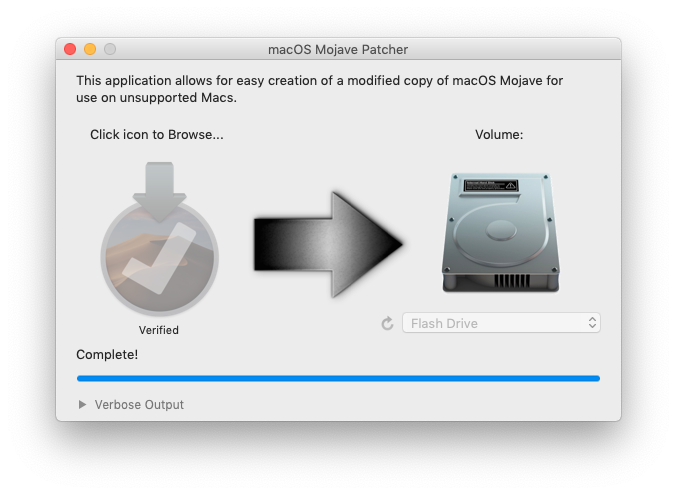APFS BootROM Support: If you have a machine that supports High Sierra natively, you MUST ensure you have the latest version of the system's BootROM installed. If you have NOT previously installed High Sierra, you can download and install this package (if running OS X 10.10 Yosemite or later) to install the latest BootROM version (you MUST reboot after installing the package to apply the. Install VMware Tools on macOS Sierra. Download Darwin.ISO from the link below and place it on your desktop. VMware Tool ISO File Downlaod Tool iso file is on the Tools folder in Patch tool. Install Patch Unlocker Tool The previous article, also I talked about Patch tool and the patch is a simple software that is designed and developed on Command prompt. In order to allow the users to show the macOS operating system on the list of other operating systems on VMware player. Insert your desired USB drive, open Disk Utility, and format it as OS X Extended (Journaled). Open the 'macOS High Sierra Patcher' tool, and browse for your copy of the macOS High Sierra Installer App.
Updater tool that helps you get and install the latest system updates for macOS Sierra installations deployed on unsupported Mac models

macOS Sierra can be deployed only machines manufactured after late 2009 which leaves behind users that still use older Macs. What’s more, if you choose to use alternative solutions to deploy the OS on models that are not officially supported, you will not be able to get the latest updates.
macOS Sierra Software Update Patch is a small tool that can help you bypass this issue: just run it on a macOS Sierra copy deployed on an unsupported Mac, and the app will let you choose the update you want to apply.
Patcher tool that sports a very intuitive configuration process
macOS Sierra Software Update Patch comes with a simple user interface where you get to interact with its capabilities in an intuitive manner. The app automatically detects updates available for your machine and enables you to download and install the patches.
Note that you can also manually push the “Refresh Updates” button to check if there are no patches available for your Mac. In addition, you can fix permissions or launch the App Store application.
When everything is set, all you have to do is press the “Patch Update” button, and the utility will take care of the rest. However, keep in mind that macOS Sierra Software Update Patch works only if the System Integrity Protection system is disabled on your Mac.
For your convenience, macOS Sierra Software Update Patch will check if it can apply the update and delivers instructions on how to disable the SIP if it interferes with the tool: navigate to the Terminal and run the appropriate command (“csrutil disable”).
Unsophisticated solution for patching Sierra installations running on unsupported Macs
Bottom line, macOS Sierra Software Update Patch is a companion tool for the macOS Sierra Patcher utility that enables you to make a Sierra bootable USB that will work on unsupported Macs.
macOS Sierra Software Update Patch will simply help you get the latest software updates even if you have deployed macOS Sierra on an older machine that is not included in the list of officially supported models.
Filed under
macOS Sierra Software Update Patch was reviewed by Iulia Ivan- Installed and working copy of macOS Sierra on an unsupported Mac
macOS Sierra Software Update Patch 3.1
add to watchlistsend us an update- runs on:
- macOS 10.12 or later (Intel only)
- file size:
- 2.6 MB
- filename:
- macOS Sierra Software Update Patch.zip
- main category:
- System Utilities
- developer:
- visit homepage
top alternatives FREE
top alternatives PAID
Patcher Tool Download
With macOS Sierra, Apple has once again raised the bar on which Macs can install and run the newest version of the Mac OS. But as sometimes has happened in the past, there are workarounds that make it possible to install Sierra on some unsupported Macs.
A huge thank you to Collin Mistr for developing and sharing his macOS Sierra Patcher Tool for Unsupported Macs. Mistr is a member of our Low End Mac group on Facebook, and he’s been sharing this tool ever since he figured out how to install the first public beta of Sierra. Several members of our group have used the tool and shared their results.
Apple Requirements for macOS Sierra
Your Mac must have at least 2 GB of memory and 8.8 GB of available storage space. You must also be running Mac OS X 10.7 Lion or later. (For those still on OS X 10.6 Snow Leopard, you can upgrade to OS X 10.11 El Capitan for free and then install macOS Sierra.)
- Late 2009 iMac or newer
- Late 2009 MacBook or newer
- Mid 2010 MacBook Pro or newer
- Mid 2010 Mac Pro or newer
- Mid 2010 Mac mini or newer
- Late 2010 MacBook Air or newer
All Macs introduced in the past six years are supported, as well as the consumer MacBooks and iMacs from late 2009, which are almost 7 years old. The official macOS Sierra installer will refuse to install on anything older.
Real Hardware Requirements for macOS Sierra
Again, your Mac needs at least 2 GB of RAM and 8 GB of available storage, and you’ll need a USB drive (thumb drive or hard drive) at least 8 GB in size. You will also need a Mac with an Intel Penryn Core 2 Duo or later CPU, since Sierra requires SSE4.1 – and older versions of the Core 2 Duo, such as Merom, and older Xeon chips (used in the Mac Pro) don’t have it.
mac OS Sierra Patcher Tool for Unsupported Macs supports the followining:
- Early 2008 Mac Pro or newer
- Early 2008 iMac or newer
- Early 2008 MacBook Pro or newer
- Late 2008 MacBook Air or newer
- Early 2009 MacBook White or newer
Where Apple only supports some Late 2009 and Mid 2010 Macs, Mistr’s patch supports all Early 2009 Macs, some Late 2008 Macs, and even some Early 2008 Macs. We have a full list of Macs that can unofficially install Sierra using using the Unsupported Sierra tag. We will also be updating these profiles with #unsupportedsierra as time permits.
You Can Install It, But…
That’s a lot more low-end support than Apple offers, so what’s the catch?
There has been an issue with some of the Apple AirPort hardware in older Macs, but other than that, it’s pretty much clear sailing. The AirPort support depends on which WiFi module your Mac uses. If it is not the Broadcaom BCM4321, you’re set.
High Sierra Patcher Tool
Other issues include the trackpad in the 2009 MacBooks and loss of volume control on the Early 2008 iMac. Details below.
Unsupported Devices


- The Broadcom BCM4321 WiFi module used in many older Macs is not supported. You will need to replace it with a compatible module or use a USB WiFi dongle. Models that may have this module include:
- Early 2008 Mac Pro (MacPro3,1)
- Early 2009 and Mid 2009 MacBook (MacBook5,2)
- Early 2008 and Late 2008 MacBook Pro (MacBookPro4,1) but the 15″ Late 2008 MacBook Prois supported
- Early 2008 iMac (iMac8,1)
- Early 2009 and Late 2009 Mac mini (Macmini3,1)
- Late 2008 and Mid 2009 MacBook Air (MacBookAir2,1).
- The trackpad in the Early 2009 and Mid 2009 MacBooks is not fully supported. Sierra sees it as a standard mouse; you cannot change the trackpad orientation settings.
- Some Early 2008 iMacs have an audio issue that will not let you adjust sound volume.
Mac Os Sierra Patch Tool
Real World macOS Sierra Requirements
Memory
Sure, you can install and run macOS Sierra on a 2 GB Mac, but you’re not likely to be happy with system performance. You have a couple browsers running or several tabs in one browser, and that amount of memory will really hobble performance.
Heck, I find 3 GB on my 2.0 GHz 2007 Mac mini with OS X 10.6 Snow Leopard barely adequate. Then again, I often have 3-4 browsers running, many open tabs, and some additional apps.
My 2.0 GHz Late 2008 Aluminum MacBook has been running OS X 10.9 Mavericks and 10.11 El Capitan decently with 4 GB of memory, and that should be adequate for most users. Power users, however, will want at least 8 GB of memory.

A Fast Drive
Nothing will make your aging Mac seem fast like a Solid State Drive (SSD). Where hard drives are limited in how fast they can read data off a spinning platter, SSDs have no such limitation. Speed is almost completely limited by the speed of the SATA connection in your older Mac. Macs with 1.5 Mbps SATA will seem very fast with an SSD, those with 3.0 Mbps SATA will seem wicked fast, and those with 6.0 Mbps SATA will seem insanely fast.
SSDs have become very affordable over the past year. I have 256 GB and 480 GB SSDs in my Mac mini and MacBook respectively, and they made a world of difference.
If you need really high capacity or are on a very tight budget, look into newer 7200 rpm hard drives to replace your older hard drives. Newer drives tend to be faster and have larger data buffers, which boosts performance.
A third option if hybrid hard drives, which are part hard drive and part SSD. The drive itself manages which files are on the SSD and which remain on the hard drive platters, much like Apple’s Fusion Drive. I have tried hybrid, and while it was nicer than a straight hard drive, it doesn’t compare with a full fledged SSD. For some users in some applications, though, it might be a perfect mix of hard drive capacity and sometime SSD throughput.
In Closing
Roblox player exe roblox installer. We Mac geeks have had a long history of hacking Mac OS X to run on unsupported hardware – starting with OS X 10.2. The biggest success was probably the unsupported installer hack for OS X 10.5 Leopard, allowing easy installation on Macs with G4 CPUs below the official 867 MHz threshold.
Collin Mistr’s patch is the same kind of thing for macOS Sierra. If your Mac is not supported by Apple but is by Mistr’s patch, give it a try. I think you’ll like it.
Keywords: #macossierra #unsupportedmacs #unsupportedsierra
Short link: https://goo.gl/InL5NS
searchword: unsupportedsierra